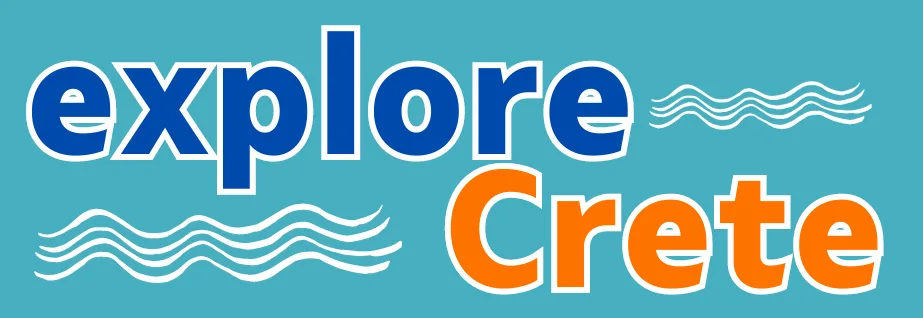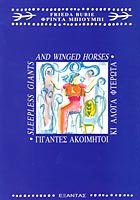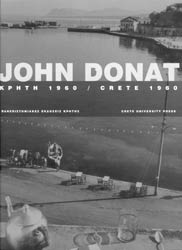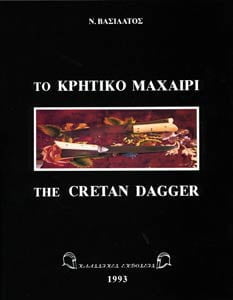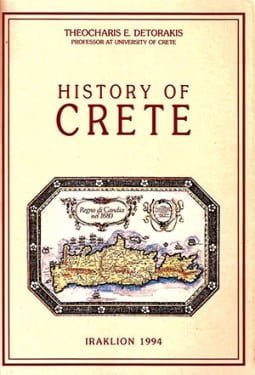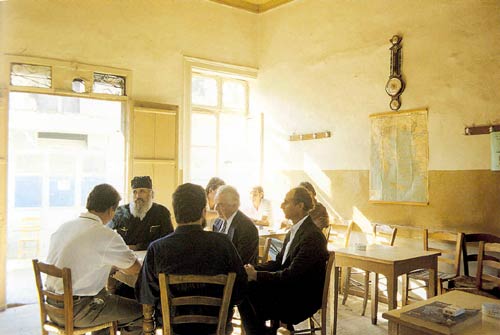The White Mountains of Crete by Loraine Wilson
Published by Cicerone Press (2000), small 8vo, paperback, pp 186 + bibliography
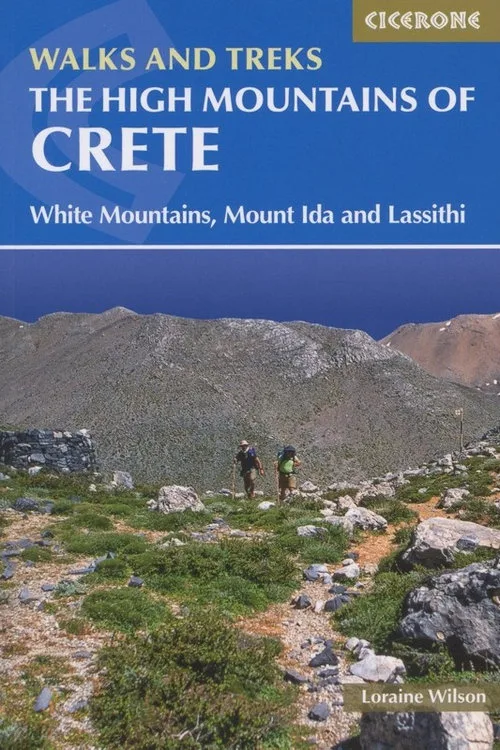
The White Mountains (Lefki Ora) are situated in the west of Crete and dominate the landscape. You’d be forgiven for thinking that the range is named after their dazzling snow-capped appearance, which remains on the tallest peaks well into the summer months, though they are actually called “the white mountains” due to their geological make-up; a very light coloured limestone.
The tallest mountain within this beautiful range is Mount Pachnes, a mere 3 metres shorter than Mount Ida (‘Psiloritis’ or occasionally ‘Stavros’), which is the highest mountain on the island. Locals of the area are prone to place rocks on Mount Pachnes’ summit in an attempt to peak the other peak, as it were, though as I get older, I am convinced that Ida is growing too! On an island where walking is one of the great attractions, the White Mountains are widely regarded as the having the best walks of all. Do not be put-off, if you are not a mountaineer, as while some walks do take you above the eagles’ nests, there are plenty of coastal walks, gorges and treks which end up at the sea too. There is likely to be something for everyone to enjoy, whatever their physical condition, age or experience, in this excellent guidebook.
The walks in ‘Crete: The White Mountains’, cover five distinct areas: ‘The Omalos Plateau’, ‘The Northern Foothills’, ‘The Askyfou Plateau’, ‘Anopolis’ and ‘The South Coast’ before we get to the (mostly) more arduous treks, all of which are described in reverse as well. This means that the starting point is optional which is a great idea as too many guides rely on ones ability to be able to reverse these walks in ones mind – mid-hoof – which is a far easier thing to do on paper than in practice. I have listed all the walks and treks at the bottom of this page so that you can get an idea of the book’s diversity, though pretty much every level of experience and tolerance are catered for. The grading system is also explained in more detail below, but in short: ‘A’ is the easiest and ‘E’ the toughest. For those who have walked the Samaria gorge (and if you have been to Crete and haven’t walked the longest gorge in Europe, what were you doing?), a good frame of reference as far as the grading system is concerned, is that Ms Wilson classifies that walk as a ‘B’.
The Trans-European hiking route (E4), starts life in the Pyrenees and meanders its way through Europe before reappearing in Crete at Kastelli, west of the White Mountains. From here the path heads in a southerly direction round the west coast of Crete and then east, before splitting into two separate and distinct paths at Soughia. There, the E4 ‘alpine’ route heads north to Omalos, then east past Mt Pachnes to Asfikou, before heading back south – via the Imbros gorge – to join the E4 ‘coastal‘ route at Kommitades. Meanwhile, the coastal route has followed the south coast via Ay. Roumeli, Loutro and Chora Sfakion. This means that there are plenty of well-trodden paths; both in the mountains and along the coast and each of these routes are well catered for in Ms Wilson’s book. Do look at the grades before embarking on one of these walks; it is easy to believe the coastal walks will be a doddle and some of them, most certainly, are not.
I am delighted to have been granted permission by the author, to reproduce one of the walks from her guide. Not just any old walk either, but the most popular of them all: ‘The Samaria Gorge Walk’. I believe by its inclusion you will see how thorough and expertly written the book is and seeing that many of you will have had previous experience of this walk, your appetites should be whetted for more of the same. Crete is not a “one walk” island and Ms Wilson has described in the same expert way as the one reproduced below, 48 other walks and a further 10 treks. All of these are splendid and the advantage of walking the less-well-known ones, obvious. True, the Samarian gorge is the longest gorge in Europe and is a wonderful hike in one of the most beautiful national parks anywhere in the world. I would definitely advise anybody visiting Crete to walk this gorge if they’re able. Saying that, in excess of 2,000 people a day, tramp down the Samaria gorge during the busiest months of the year. So unless you get up at the crack of dawn or spend the previous night at Omalos, you are very likely to be involved in a procession. Last year my attempt to walk to the top of the Samaria gorge and back on the same day, was scuppered by the throng that greeted me travelling in the opposite direction. I am of course well used to this adoration but the sheer quantity of people coming down made the ascent very difficult (a quite lame excuse I know, but I was quite lame at the time; if you do try walking against the tide by ascending the gorge, you get to realise just how many people actually come down it, something that you can’t imagine when descending it). Try one of the other gorges in this book and you may find that you have total solitude at times and on some of the mountain walks you will not see a soul for hours upon end.
For the sake of objectivity, I always like to point out things within a book which I would deem as less than perfect and feel that I should mention a couple of minor flaws within this one too. When I used this book last year, I realised that the maps were not good enough for the walks involved. No problem there as I had with me the recommended ‘Harms’ map to Western Crete (1-100,000).Trouble here though, is that neither that map nor the book have an index, so I would say that it would be better to take the Road Edition map, which is a smaller scale (1-200,000) but still very detailed and does have an index of place names. That the book is lacking an alphabetical index is a slight flaw, though as you can see from the contents list (below), the areas are very neatly divided into geographical regions, so it should be very easy to find the correct walk for the area you wish to set-off from. Not surprisingly, things go out of date very quickly and guidebooks are forever in need of updating. Thankfully the walks and treks in here will remain the same for many years, but the information on how to get to the island has suffered the same fate as the ‘Rough Guide to Crete’, in that it lists the old two-airport system for Athens. (I shall put that straight right here and now, by informing anybody planning to fly to and from Athens that the new airport, near the village of Spata, is called ‘Eleftheros Venizelos’ and is 27km east of the city). The remainder of the introduction has useful information, but as this is a specialist guidebook it may be wise to take along a more general one, if you need more in depth details, such as accommodation or car-hire.
This is not the only walking guide to Western Crete. Also available are the Sunflower “Landscapes of Western Crete” – which I have a great fondness for – and Gert Hirner and Jakob Murbock’s ‘Rother’s Walking Guide: Crete – West’ which is also a very useful guidebook. Cicerone, the publisher’s of “Crete: The White Mountains”, used to publish one called ‘Crete: Off the Beaten Track”, which is sadly out of print. Saying that, if I had to choose just one of these guidebooks to accompany me to western Crete, there is no doubt it would be this one.
The guide’s format is small, light and eminently portable. There are guides with more information on the Samarian gorge than in the description below. What this book does is guide you, rather than hold your hand. Some of the walks are hazardous and those hazards are pointed out, but forward-planning would be a wise idea, especially with the higher graded walks. My own plan to walk from Xerokampos to Gramvoussa in 2003 will be highly reliant on one particular section of this book. Before I start that walk I shall be climbing Mount Gingilos and then walking the ‘alpine’ E4 trail from Omalos to Askyfou, skirting Mount Pachnes and then heading south to Chora Sphakion, so that I can get a good idea what to expect when walking in the reverse direction a couple of weeks later. I shall be highly reliant on the accuracy of Ms Wilson’s descriptions during these excursions and believe that my faith in her book will be rewarded.
Any further comment would be superfluous as you may judge for yourselves the expertise of Ms Wilson’s walks by reading the following excerpt from the book, which has been reproduced in full. It should be remembered that there are 59 walks and treks in all, so other books may have more thorough descriptions of this walk, but only a certain amount of space can be alotted to any particular hike in a book of this nature.
Stelios Jackson and ‘Explore Crete’ are indebted to Loraine Wilson the author of ‘Crete: The White Mountains’ for allowing us to reproduce the following walk in its entirety and to Lesley Williams for all her efforts, including tracking down Ms Wilson mid-trek and for sending Stelios the walk below in a format which allowed me to directly copy it; an absolutely enormous help.
The description that follows remains copyright Loraine Wilson, 2000.
“Crete The White Mountains: Walk 2. The Gorge of Samaria”
See also Walk 46
Grade: B
Starting point: Xyloscala (1,250m/4,100ft) – Omalos
Access: KTEL Omalos bus or taxi from Chania
Finishing point: Ay. Roumeli
Access: Coastal boat service (see details below)
Approximate distance: 18km (11mls)
Time allowance: Xyloscala to Ay. Nicolas chapel: 1hr 30mins; to Samaria old village: 1hr 10mins; to Iron Gates: 1hr 10mins; to Park Boundary: 40mins; to Ay. Roumeli waterfront: 30mins. Total 5 hrs.
This hugely popular walk down the Samaria Gorge has brought much prosperity to western Crete. Cretans now recognise that tourists often enjoy shady gorges as well as beaches and several other gorge-walking routes have become popular.
Although the Samaria Gorge has developed in this way, part of it was designated a nature reserve as long ago as 1929 when biologists recognised that the Cretan ibex, or agrimi – affectionately called the kri-kri – would soon become extinct if they didn’t take steps to save it. This ongoing project has had its ups and downs, year by year, but it is the fundamental reason the gorge is nowadays a well organised National Park run according to World Conservation Union standards.
The agrimi is a little mountain ibex, or wild goat, rather like a St. Kilda sheep, but with a black stripe down its back. An old male with huge horns that would be valued by hunters may not exist in the wild at present. In the autumn, when food is scarce, ‘tame’ agrimi with their young forage for food behind Samaria old village in spite of the many people gathered there at midday. They may also raid the litter bins by Ay. Nicolaos chapel (the first main stopping point on the route down) in the afternoon when most walkers have gone. Occasionally they leave the gorge. Amongst domestic goats nearby you may see half-breeds with black stripes down their backs.
A river fed by mountain springs and snow-melt runs down the gorge, disappearing and reappearing at intervals, which is typical of limestone terrain. Stepping stones are positioned at the many river crossings on the walk. For those who prefer to wade (bring sandals) the river is not fast-running by the time the gorge opens to the public on l May and its flow will lessen each week.
Principal man-made features are the old village of Samaria halfway down, from which the population was resettled in the 1960s, and the old village of Ay. Roumeli, just outside the park boundary at the bottom. New Ay. Roumeli is 1 kilometre further on, right on the sea shore. Other constructions in the gorge, apart from mule tracks, are chapels, ruined Turkish forts and water conduits to ruined sawmills or used for irrigation.
The park makes a significant cultural contribution by inducing town-dwelling Cretans to rediscover the beauty and worth of their own countryside and the pleasures of walking. Locals can choose their day: overcast, cool Sundays are preferred, when whole families can be seen trooping down alongside the tourists.
As this part of the south coast is free of roads, tour groups finish by being transferred from Ay. Roumeli to Hora Sfakion, or Souyia, by boat where they are met by the same coaches that took them up to Xyloscala. It is a long round for the bus drivers and an even longer day for the tourists. This standard tour method of hurrying down the gorge, and then leaving it almost immediately, detracts from the experience and does not fully reward the effort involved. Walk outside the ‘rush hours’ and make a point of staying overnight in Ay. Roumeli if you can.
Directions
The main trail is so well tramped that it is easy to follow and needs no signposting. Instead, signboards indicate points of interest. Wardens patrol the route throughout the day and a mule-borne rubbish-collection patrol operates late afternoon, after most walkers have gone. Keep your ticket; it is collected in as part of a census procedure at the other end.
Boat departures from Ay. Roumeli to Hora Sfakion are likely to be at 12.00, 15.45, 17.30 and 19.30 during the main tourist season. A skeleton service operates at other times. The 12.00 and the 15.45 boats usually call at Loutro. For Souyia, departure is likely to be at 16.00. Journey time in either direction is about 45 minutes, varying with the weather or a call at Loutro (an extra 30 minutes) or both. The last KTEL evening bus to Chania (usually packed) waits for the boat (see Public Transport section, page 14). The ticket kiosk with the latest timetables is at the bottom of Ay. Roumeli main street (see South Coast section, page 137). You can always enquire at the waterfront Tara restaurant (the landlord speaks English) if anything unusual seems to be happening.
The National Park entrance fee is about 3.00. It is open from 1 May to 31 October, depending on weather conditions. There are no commercial outlets inside the park. There is no camping. A guide book is on sale at Xyloscala and Omalos. Drinking water, WCs and smokers’ stopping places are provided at intervals. The Park closes at the top about 5 hours before the last boat leaves Ay. Roumeli (see South Coast section, page 137 and Walk 46).
Organised day tours have left Xyloscala by 14.00, so an early afternoon start allows you to walk down relatively undisturbed. Otherwise, start around 7.00am when the ticket kiosk opens, having stayed overnight on the plateau. Deliberately planning these alternative times is well worth it as this lovely walk is downgraded if too many people are doing it at the same time – a daily average of 2000 is normal. In spite of all this activity, the gorge is still a wild, rugged and potentially hazardous place. Always be on the alert for falling rocks – rain followed by wind dislodges them most readily. The park may be closed under these conditions. Tired or injured people, who finish the trip riding one of the few ‘rescue’ mules from Samaria village (which is expensive), sometimes hurt themselves further by falling off the mule, as the pack-saddles are extremely uncomfortable. On rare occasions desert-like flash floods occur, when the parched land cannot absorb the first storms of winter. It is sensible to be at least aware of this if a storm occurs. Unmaintained paths off the main trail are closed to the public (due to accidents in the past) and special permission from the Forestry Directorate of Chania is needed for access to them.
Towards the end of the walk, note the Turkish fort on the western skyline above the valley. The climb to it is not as far as it looks and for unhurried walkers (wearing boots) it makes an interesting and unconventional way of arriving at Ay. Roumeli (see Walk 47).”
– COPYRIGHT: Loraine Wilson 2000-
A note on walking times: Ms Wilson uses the following rules of thumb: “15 minutes per 100 metres of height gained and per approximate linear kilometre; 15 minutes on roads, 20 minutes on easy-to-follow rough footpaths; 30 minutes on very demanding terrain.”
The Grading System
The walks and treks are graded A-E in order of difficulty, with a few subdivisions thrown in for good measure:
Grade A: Short walks, easy underfoot, with hamlets or destinations in sight.
Grade B: Walks on popular, well tramped, easy-to-follow trails
Grade C Walks on less frequented or mountain footpaths.
Grade D: Tough day-walks on remote terrain. Confidence and route finding experience is needed. Any of the backpacking routes, as these are mini expeditions that need careful planning.
Grade E: The toughest backpacking routes
Crete: The White Mountains – Table of Contents
- Preface:
- Practical Information
- Getting to Crete
- Flying to Athens
- Direct Flights
- Getting to the Trailhead:
- Public Transport
- School bus and Villagers’ shopping Transport
- All-year Round Main Bus Routes
- Taxis
- The Language Barrier
- Accommodation and Shopping:
- Time Differences
- Lost Luggage
- Weather
- Photography
- Water
- Shelter
- Types of Pathway
- Walking Technique
- The E4 Trail
- Backpacking and camping
- Water Bottles
- Daysack Essentials
- Blisters and First Aid
- Compass and Altimeter
- Maps
- Clothing and Footwear
- Route Notes:
- Grading System
- Walking Times
- Point to Point Route suggestions
Reviewed by Stelios Jackson 15/7/02
Buy the book The High Mountains of Crete from Amazon.co.uk
© explorecrete.com All Rights Reserved. Reproduction or copying without permission is prohibited.
